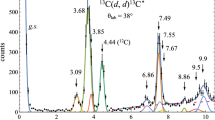Abstract
The line shape and the excitation strength of the very weak first excited Jπ=1/2+ state at Ex=1.684 MeV in Zeitschrift für Physik Zeitschrift für Physik9Be has been investigated with high-resolution inelastic electron scattering at E0=45 and 49 MeV and scattering angles θ=105°, 117°, 129° and 165°, and with high-resolution inelastic proton scattering at E0=13MeV and θ=15° and 18°. Due to lying just above the neutron threshold the level has a strongly asymmetric line shape which in both experiments can be described consistently with a Breit-Wigner expression modified on the low energy side by the threshold behaviour of the cross section. The resonance energy is ER=1.684 ± 0.007 MeV and the width T=217± 10 keV in thec.m. system. A single particle potential model calculation reproduces the line shape and the resonance parameters fairly well. In addition, the inelastic electron scattering form factor has been measured. In the range of momentum transfersq =0.24-0.46 fm−1 it is dominated by a 0p3/2→ 1s1/2 particle-hole transition. The transition is mainly longitudinal and of isoscalar nature with a strength of B (E1)↑ =0.027 + 0.002 e2 fm2, but a small M2 contribution ofB(M2)↑=8.8 ±1.5 μ 2N fm2 has also been detected.
Similar content being viewed by others
References
Ajzenberg-Selove, F.: Nucl. Phys. A413, 1 (1984)
Barker, F.C.: Can. J. Phys.61, 1371 (1983)
Endt, P.M.: At. Nucl. Data Tables23, 3 (1979)
Barker, F.C., Treacy, P.B.: Nucl. Phys.38, 33 (1962)
Jeremie, H.: Can. J. Phys.49, 2085 (1971)
Watson, K.M.: Phys. Rev.88, 1163 (1952);
Migdal, A.B.: Zh. Eksp. Teor. Fiz.28, 3 (1955) transi.: JETP (Sov. Phys.)1, 2 (1955)
Berman, B.L., Van Hemert, R.L., Bowman, C.D.: Phys. Rev.163, 958 (1967)
Sherr, R., Bertsch, G.: Phys. Rev. C32, 1809 (1985)
Millener, D.J., Kurath, D.: Nucl. Phys. A255, 315 (1975)
Jäger, H.U., Kirchbach, M.: Nucl. Phys. A291, 52 (1977)
Millener, D.J., Alburger, D.E., Warburton, E.K., Wilkinson, D.H.: Phys. Rev. C26, 1167 (1982)
Millener, D.J., Olness, J.W., Warburton, E.K., Hanna, S.S.: Phys. Rev. C28, 497 (1983)
Van Hees, A.G.M., Glaudemans, P.W.M.: Z. Phys. A — Atoms and Nuclei315, 223 (1984)
Nyman, G., Azuma, R.E., Jonson, B., Kratz, K.-L., Larsson, P.O., Mattsson, S., Ziegert, W.: Proceedings of the 4th International Conference on Nuclei far from Stability, CERN-Report81-09, 312 (1982)
Nyman, G.: Private communication
Graf, H.-D., Miska, H., Spamer, E., Titze, O., Walcher, Th.: Nucl. Instrum. Methods153, 9 (1978);
Walcher, Th., Frey, R., Gräf, H.-D., Spamer, E., Theissen, H.: Nucl. Instrum. Methods153, 17 (1978);
Schüll, D., Foh, J., Gräf, H.D., Miska, H., Schneider, R., Spamer, E., Theissen, H., Titze, O., Walcher, Th.: Nucl. Instrum. Methods153, 29 (1978);
Foh, J., Frey, R., Schneider, R., Schüll, D., Schwierczinski, A., Theissen, H., Titze, O.: Nucl. Instrum. Methods153, 43 (1978)
Hinterberger, F., Ehrlich, H.G., Euler, K., Hehemeyer, W., Meyer, P., Von Rossen, P., Schüller, B., Welp, G.: Nucl. Instrum. Methods130, 335 (1973)
Spencer, J.E., Enge, H.A.: Nucl. Instrum. Methods49, 181 (1967)
Theissen, H.: Springer Tracts in Modern Physics. Vol.65, p. 1. Berlin, Heidelberg, New York: Springer 1972
Fujishiro, M., Tabata, T., Okamoto, K., Tsujimoto, T.: Can. J. Phys.60, 1672 (1982)
Clerc, H.-G., Wetzel, K.J., Spamer, E.: Nucl. Phys. A120, 441 (1968)
Meuer, D., Frey, R., Hoffmann, D.H.H., Richter, A., Spamer, E., Titze, O., Knüpfer, W.: Nucl. Phys. A349, 309 (1980)
Grünbaum, L., Tomaselli, M.: Nucl. Phys. A160, 437 (1970)
Tomaselli, M.: Private communication
Author information
Authors and Affiliations
Additional information
Dedicated to Professor Theo Mayer-Kuckuk on the occasion of his 60th birthday
Supported by the Deutsche Forschungsgemeinschaft and by the Bundesministerium für Forschung und Technologie
We are grateful to F. Hinterberger and H. Neuburger for their help with the (p, p′) measurements and to C. Rangacharyulu, H. Spangenberger and M. Tomaselli for their support in some of the theoretical problems. One of us (A.R.) thanks in particular B. Jonson and G. Nyman for focussing his attention to the many problems still associated with the first excited state in9Be which actually have led to the present investigation.
Rights and permissions
About this article
Cite this article
Kuechler, G., Richter, A. & von Witsch, W. Line shape and excitation strength of the first excited state in9Be. Z. Physik A - Atomic Nuclei 326, 447–454 (1987). https://doi.org/10.1007/BF01289549
Received:
Issue Date:
DOI: https://doi.org/10.1007/BF01289549




